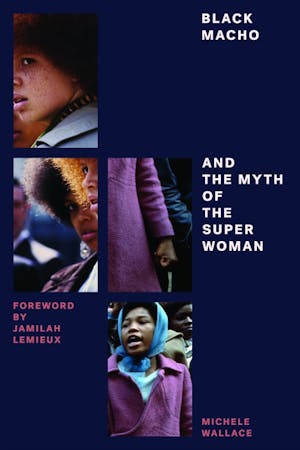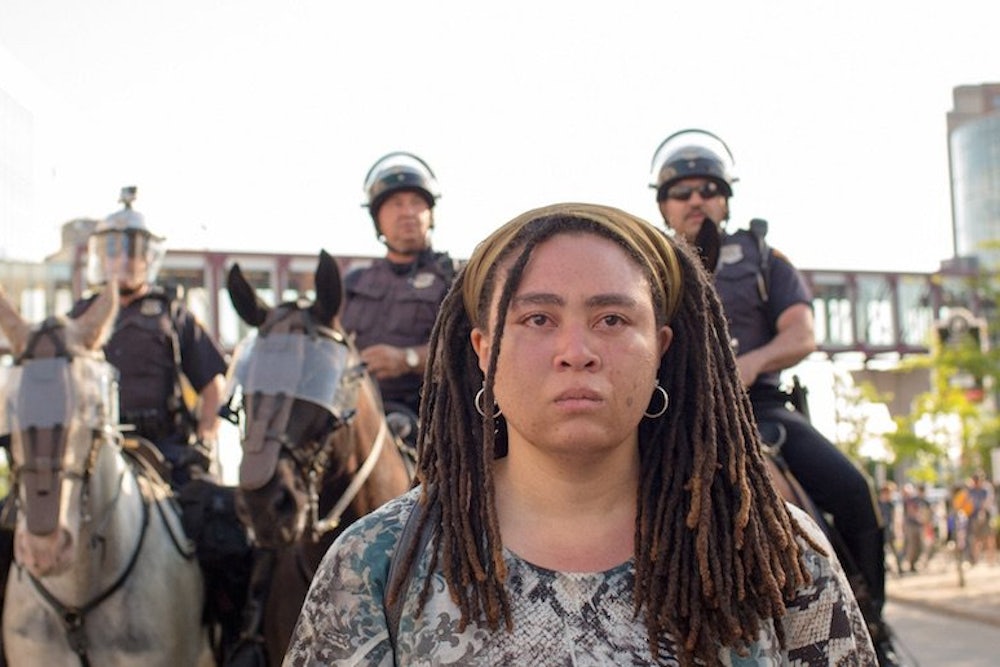When I first picked up my mother’s well-worn copy of Black Macho and the Myth of the Superwoman, I’d already been calling myself a feminist for about two years and had penned a scathing takedown of a commercial for boxed macaroni and cheese that implied mothers were somehow responsible for bringing home the pasta and boiling it in a pot.
I was thirteen.
Despite the condition of the book implying that Mom had done what I would eventually do—carry the book around in my purse until it literally fell apart—I came to find out that she wasn’t much of a fan of Michele Wallace’s controversial debut. A member of SNCC, my mother was then fiercely protective of the image of the organization and its charismatic leader, Stokely Carmichael, who would come to be known as Kwame Touré. Furthermore, like many Black women of the Baby Boomer generation, she still struggled with the idea of publicly accusing Black men of sexism—after all, isn’t the White Man our true and shared enemy? Don’t we have enough problems without the infighting?
Wallace would rerelease the book in 1990 with a brutally honest, updated introduction—“How I Saw It Then, How I See It Now”—which I read some ten years later. In it, she took herself to the woodshed for what she considers to be misunderstandings on her part:
I now feel that the biggest failure of the book was that I didn’t understand the problems inherent to nationalism as a liberationist strategy for women. I thought men were simply leaving women out because it hadn’t really occurred to them to do otherwise ... I didn’t see that it comes automatically to nationalist struggles to devalue the contributions of women.
She does, however, find space to defend herself:
My critique of the Black Power Movement was based upon a limited perception of it taken primarily from the mainstream media ... what I learned from this perspective was more important than many of my critics have been willing to allow.
Now in my early thirties, I better appreciate her ability to be self-critical and to recognize the flaws in Black Macho. However, I hope that both readers and Wallace alike see the importance of her bravery and the necessary roughness of this book. Wallace publicly walked the walk many Black feminist women do when the weight of recognizing Black patriarchy crashes squarely on our shoulders. She spoke pointedly of what scribe and scholar Moya Bailey has since labeled “misogynoir”—sexism towards Black women; anti- Blackness that can come even from those who are Black, who were raised by Black women and profess to value Black people.
I also hope that this new edition is an opportunity for audiences who were of age at the time of the original publication and young people alike to truly grasp the significance of Black Macho. Darryl E. Pinckney, who reviewed the book for the Village Voice, where Wallace later served as a columnist, panned Wallace’s work as “autobiography, historical information, sociology, and mere opinion dressed up to resemble analysis.”
Pinckney may not have been entirely wrong in his description, but what we know now, in the era of blogging, memoirs by 25-year-olds and social media oversharing, is that “mere opinion” can sometimes be as, if not more, valuable than analysis. Young Michele Wallace’s theories and theses may not all hold weight when dissected by historians and scholars, or even pass her own standards at this point in her career, but her descriptions of what young feminist/womanist thinkers of my generation have come to know as “Black girl pain” were and are extremely important.

The criticisms leveled against the modern-day Black feminists with whom I am most readily associated—a group of Gen X and millennial women and men who cut our literary teeth primarily on the internet—are similar to those Black Macho faced. Though we have become more sophisticated and pointed in our language around our issues with Black men, the attempts at silencing us have remained sadly consistent with the sort of scathing, violent attempts made by writers like Robert Staples (The Black Scholar) against Wallace. Addressing sexism in anti-racist movements is divisive! To suggest that Black women face oppression at the hands of Black men distracts us from our true enemies: Racism! White supremacy! Isn’t it fair to reason that Black women are somehow complicit in the plot to keep the Black man down, considering that Black girls allegedly fare better in classrooms and Black women outpace Black men in the workplace?
What has improved for the better, however, is that Black feminist thought has gone mainstream in ways that Wallace likely could not imagine when Black Macho was released, when the backlash was loud and immediate. When she sat with a makeup artist who didn’t know what to do with brown skin, and a hairdresser who couldn’t figure out how to make a natural look ... natural for a Ms. magazine cover that would help usher in much of the anti–Black Macho pushback, Wallace couldn’t have imagined that one day feminist and scholar Melissa Harris-Perry would be the host of an eponymous MSNBC talk show that forces the corporate glam squad to understand Black skin and box braids every weekend. It would have been impossible to predict that technology would lead us to a place called “social media,” and the ability of Black women of all classes and creeds to debate feminist thought publicly and with authority would increase tenfold.
The world that received the first edition of Black Macho was very different than the one we know today, where Black feminists have demanded more than a seat at a proverbial table, but also a microphone. It would have been impossible to predict in 1979 that Beyoncé, the biggest pop star in the world, would proudly stand in a shiny onesie in front of the word FEMINIST at the 2013 MTV Awards, only mere months after featuring a clip of author Chimamanda Ngozi Adichie defining the word itself on her latest album (though the backlash from White feminists that followed wasn’t exactly shocking).
“Feminism” is no longer a curse word in Black America. It may still be controversial, polarizing even. But it is increasingly visible, increasingly common. Search the word on Twitter and you’ll find hundreds, if not thousands, of often meaningful, nuanced conversations about what gender equity means to young Blacks—you’ll likely wade through some terribly offensive stuff to find those threads, but they exist and they are powerful.
The recent unrest in the United States over extrajudicial killings of unarmed Blacks—sparked by the violent death of Trayvon Martin in 2012 and activated again by the assassination of Mike Brown in 2014—have largely placed Black male victims at the center of the movement, but the pushback against that framing has been loud and effective. Twenty-five-year-old Jonetta “Netta” Elzie, whose activist identity was born on the streets of Ferguson in the days following Brown’s death, has become one of the most visible leaders of this movement, as have a number of other St. Louis–based millennial women: Brittany Packnett, Ashley Yates, Brittany Ferrell, Alexis Templeton, Erika Totten.
In fact, the Black Lives Matter banner under which these protests, rallies, die-ins and mobilizations have come to be known was shaped by three Black queer women: Patrice Marie Cullors, Opal Tometi, and Alicia Garza.
These women have not been able to lead without their challenges; in fact, part of the reason they have become so visible is because many of them entered the movement and found a concerted effort on the parts of male comrades and White so-called allies to decentralize Blackness at all costs. But instead of being relegated to administrative duties, or allowing their efforts to be undervalued in the present but romanticized by future generations, today’s leading Black female activists both acknowledge their feminism publicly and have radically reimagined Black nationalism as truly intersectional in both policy and praxis. Garza describes the limited scope of other social justice movements, and explains how she and her comrades are approaching things much differently:
[Black Lives Matter] goes beyond the narrow nationalism that can be prevalent within some Black communities, which merely call on Black people to love Black, live Black, and buy Black, keeping straight cis Black men in the front of the movement while our sisters, queer and trans and disabled folk, take up roles in the background or not at all. Black Lives Matter affirms the lives of Black queer and trans folks, disabled folks, Black-undocumented folks, folks with records, women and all Black lives along the gender spectrum. It centers those that have been marginalized within Black liberation movements. It is a tactic to (re)build the Black liberation movement1.
I interviewed Michele Wallace for the March 2013 issue of EBONY, for a feature on the burgeoning presence of Black feminist thought online, “Black Feminism Goes Viral.” One of the things we discussed in our beautifully lengthy interview (which was, of course, reduced to a few digestible nuggets for print) was how her feminist identity may have had a toll on her romantic relationships and she had never had children as a result.
I thought long and hard about this when we got off the phone and I have to disagree. Michele Wallace has a lot of children: She has Joan Morgan, dream hampton, Mikki Kendall, Feminista Jones, Mychal Denzel Smith, Trudy, Marc Lamont Hill, R. L’Heureux Lewis-McCoy, Brittney Cooper, Rahiel Testafamariam—and if I am nothing else in this world, I am a daughter of Michele Wallace. Furthermore, the ways in which Black Lives Matter differs from the Black Nationalism that Wallace skewered in 1979 makes it plain, for me at least, that our world is better for the bravery of Black Macho, even if it was ahead of its time.
Though she may not always see eye-to-eye with some of the feminist thinkers to come after her (and vice versa), I believe firmly that we have benefitted tremendously from Wallace’s ability to boldly say that Black patriarchy is a thing, a real, measurable thing, and Black women have been harmed by it. We have had our tongues loosened by Wallace acknowledging that the Civil Rights and Black Arts/Black Power movements unfairly required “super” Black women to put on their marching shoes and pick out their Afros to support and protect the existence of Black Macho without the expectation that we would be considered as equal partners and equally deserving of liberation.
My friend and comrade Cherrell Brown, an activist sister who has become one of the more visible faces of New York’s anti–police brutality movement, often speaks about the power of naming things: the importance of having language to speak about trauma and oppression. Wallace did a phenomenal job of “naming” in this book, of identifying these two destructive archetypes and structures that have been such a barrier been Black people and freedom: the limiting, sexist Black Macho archetype and the Black Superwoman, who Ntozake Shange described as “impervious to pain.”
The bold and brave naming that Michele Wallace did in 1979 did not receive the credit it deserved then. I hope that we are better equipped to appreciate it now.
Garza, Alicia, ‘A Herstory of the #BlackLivesMatter Movement’, 6 December 2014.
This essay originally appears as the foreword to Verso Books' republication of Black Macho and the Myth of the Superwoman, forthcoming June 9.
